The Canyons – a filming survival guide
Some of the most picturesque backdrops for filming are found in remote canyons. The prospect of shooting in one of these locations can be daunting but a few basic steps can ensure a seamless and safe operation.
 A canyon can be loosely defined as a deep ravine between cliffs usually carved by moving water. Canyons are natural funnels of water and debris, and the resulting environment is one of unique hazards: rockfall, flashfloods, logjams, deep pools, seemingly impassable obstacles, confined spaces, and high angles all packed into parent environments ranging from alpine and desert to tropical and arctic.
A canyon can be loosely defined as a deep ravine between cliffs usually carved by moving water. Canyons are natural funnels of water and debris, and the resulting environment is one of unique hazards: rockfall, flashfloods, logjams, deep pools, seemingly impassable obstacles, confined spaces, and high angles all packed into parent environments ranging from alpine and desert to tropical and arctic.
Scouting
It’s critical to know the writer and director’s visual concepts for the production. Storyboards are an enormous help if available.
A major technical consideration is lighting. The walls of a canyon block the sun creating issues of low light.
Scouting canyons can be extremely time-consuming and needs to occur early, especially where multiple permissions must be obtained. A single canyon can be subject to private ownership as well as jurisdiction from national, state, local, and tribal land and water management agencies.
Among the issues a scout will be focusing on are: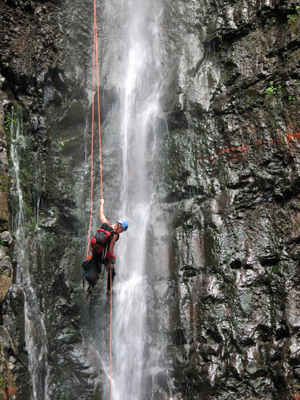
- remoteness and convenience to other locations
- minimum impact (including local traditions and ethics, artifacts and ruins, etc.)
- tourist/recreational traffic that may block the canyon and delay the shoot
- hazard awareness and risk analysis
- crew health and safety
- local weather patterns
- alternate locations
- technical issues
- clearing the locations
- access – how will the crew get in and out?
A major technical consideration is lighting. The walls of a canyon block the sun, creating issues of low light, minimal diffuse light, or extremely directional and brief sun exposure. In addition to the normal photographs and data (GPS coordinates, bearing, time of day, etc.) the scout may want to consider getting reverse- and multiple angle photos, including close-in and panorama, at various times of day. Note ambient lighting conditions and angle to the sun. Scouts can also get a very general idea of sun shadow trends on Google Earth.
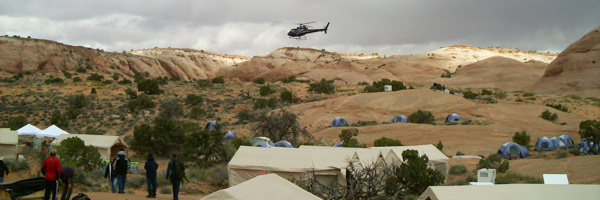 Danny Boyles’ 127 Hours is a definitive example of successful cinematography in a seemingly impossible canyon. The photo below (courtesy of Brett Sutteer) shows the over-the-slot deck built into Blue John Canyon and the photo above is part of the enormous tent city that was sling-loaded by helicopter to that location.
Danny Boyles’ 127 Hours is a definitive example of successful cinematography in a seemingly impossible canyon. The photo below (courtesy of Brett Sutteer) shows the over-the-slot deck built into Blue John Canyon and the photo above is part of the enormous tent city that was sling-loaded by helicopter to that location.
The size and complexity of the production had environmentalists and land agencies worried about impact and safety, but extensive safety precautions and superb location management kept it moving smoothly and left virtually no trace.

In lieu of expensive cameras, which routinely get thrashed in the canyons, I often use an i-phone. The camera gives me 3 MP, and in an Otter case it is water, dust, and shock resistant. Its Theodolite Pro app will imprint the photo with GPS data, bearing, camera angle, range, and time, and will mark locations on a satellite or hybrid map. I make additional notes using the phone’s voice recorder or notes apps.
That said, it can be risky relying too much on this type of technology in remote canyon areas: GPS needs unobstructed skies for accuracy, and data/cell networks will not work in remote or deeply confined slots. Any device relying on external signals or data not managed internally is subject to failure.
Canyon locations are often very remote and access can be quite technical and hazardous. To make things easier and safer, make good use of locals who live and work in the target locations. Equipment and crew can be subject to wind, sand, extremes of heat and cold, water, confined space, high angles and dangerous edges, loose rocks, and bad weather. If possible, the logistics of supply, replacement, spare parts, and other technical contingencies should be worked out by the location manager ahead of time.
Health and Safety
Adequate insurance for the crew is vital. The location scout/manager should have a solid knowledge of how to access evacuation and medical services. Larger productions will want their own medic on location. When choosing medical and other support staff, make sure they’re physically capable of responding to the site. An overweight, out of shape EMT in a remote slot canyon is NOT an asset.
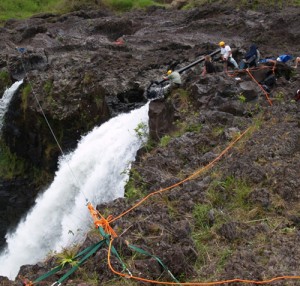 The crew of Life on location in Hawaii (pictured right) saved hips and heads by using helmets, proper footwear, and clipping crew and equipment into safety lines. In high-angle and swiftwater canyon environments, the PM should consider using certified experts for safety management.
The crew of Life on location in Hawaii (pictured right) saved hips and heads by using helmets, proper footwear, and clipping crew and equipment into safety lines. In high-angle and swiftwater canyon environments, the PM should consider using certified experts for safety management.
Two critical elements of self-care will keep a crew healthy: hydration and proper clothing. They are the keys to avoiding both heat- and cold-related injuries (heat exhaustion and hypothermia). Clean water should be available for everyone, everywhere, all throughout the shoot. In the cold, calories are also important.
Take charge and issue clear, firm instructions to the crew in this regard. Too often we find crew members stranded on a miserable all-day shoot with their bag of clothing, water, and snacks sitting in some other inaccessible spot.
A slip can cause serious injuries, and near the edge can result in people and equipment being swept over.
Expect it to be colder, hotter, and wetter than normal, and make sure the crew is outfitted with the equipment and knowledge to adjust to the extremes. Two excellent references on working in these environments are Canyoneering: A Guide to Techniques for Wet and Dry Canyons and Mountaineering: The Freedom of the Hills.
Issues of local animals, bugs, annoying plants (e.g. poison ivy) and diseases should be researched early on by the scout. Again, talk to the locals.
Canyons are notorious hideouts for outlaws. Southern Utah’s Robbers Roost, for example, is an old canyon hideout now frequently used for productions. Because of their remoteness and proximity to water, canyons are also prime territory for marijuana farmers. Copper Canyon and the canyons of Maui are great examples. Although I’ve never heard of film crews being injured or blatantly attacked, farmers can block permissions and booby-trap access points. Again, check with the locals.
Swift Water and Canyon Streams
Many canyon locations are adjacent to dangerously swift water. If filming in or at the edge of the stream, steps should be taken to protect the crew from entrapment and drowning hazards. Precautions might include the use of personal flotation devices and safety lines. The nature of the hydraulic hazard makes it advisable to consult experts or, better, employ them on-scene.
High-angle filming or filming on the edge is obviously hazardous to both crew and equipment.
Canyon floors are slick and uneven, often littered with boulders and timber. Some canyons are dry, others are consistently damp or wet. The slime and moss that tends to cover rocks in wet conditions is treacherously slippery. A slip can cause serious injuries, and near the edge can result in people and equipment being swept over. Save heads, hips, and precious time by wearing helmets and proper footwear. Amazing advances in shoe-sole technology have produced rubbers that are incredibly sticky on smooth and even wet surfaces. Canyoning-specific shoes are inexpensive. In the slimiest conditions, traditional felt-soled reef shoes or felt hikers make navigating the boulders easy.
Flash Floods
Flash floods are an insidious hazard often disregarded by film crews. By their very nature, canyons are collectors of storm and melt-water. The onset and speed of flooding depends on the composition and configuration of the drainage, but the major consideration is the weather.
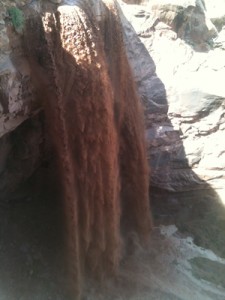 For example, two hours after a brief rain eight miles to the north, an enormous flash flood (pictured) poured over the edge of a dry Utah canyon in the exact spot a film crew was standing on five minutes prior. The photo was taken with an i-phone as the crew scrambled to get cameras in place.
For example, two hours after a brief rain eight miles to the north, an enormous flash flood (pictured) poured over the edge of a dry Utah canyon in the exact spot a film crew was standing on five minutes prior. The photo was taken with an i-phone as the crew scrambled to get cameras in place.
Location managers and safety personnel should choose a comprehensive weather website to garner up-to-date forecasts and conditions. In North America I use The Weather Underground. This free site provides current and extended forecasts, and a superb tool called the Wundermap, showing radar with animation, current warnings, USGS streamflow measurements with links to graphs, precipitation totals, and much more, all superimposed over satellite or hybrid maps.
Edge Control
High-angle filming or filming on the edge is obviously hazardous to both crew and equipment. Safety systems do not need to be elaborate and must be kept simple if the crew is expected to use them faithfully, but do require industry-standard equipment and the knowledge to set them up. Hire the appropriate experts.
Access to a canyon location often requires brief passage over short exposed or difficult technical sections of steep terrain. A scout with the proper skills can pre-set fixed via ferrata-style handline ropes and secure ladders in advance of the crew’s arrival, and can cordon off or mark dangerous areas.
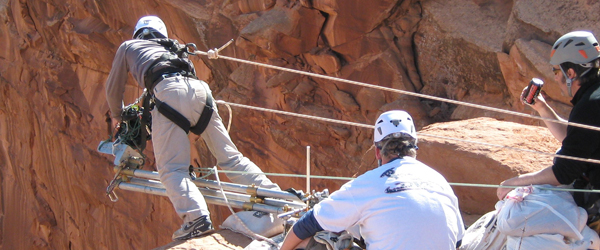 Over-the-edge shooting on the location of 127 Hours (pictured above) needed essential technical expertise to avoid catastrophe.
Over-the-edge shooting on the location of 127 Hours (pictured above) needed essential technical expertise to avoid catastrophe.
Finding Local Expertise
Many canyoning and climbing guides in southern Utah, alpine Europe, and New Zealand are experienced in scouting and production logistics. Certification as a canyon guide requires advanced high-angle rigging and expert swiftwater skills, and local guides have the added advantage of knowing weather patterns and the nuances of local geography and culture.
A browser search for canyon guides in the target geographic area should yield a number of links and contact information. Alternatively, refer to my website or email me for advice on finding qualified local expertise for your location.
Related Posts
- Filming on location: Mountain Water Safety Specialists
- The Arctic – a filming survival guide
- The Desert – a filming survival guide
- Drone filming & the freedom of unmanned flight
- Filming on location in Arizona with Location Scout Mike McGinn
- A Producer’s Survival Guide to India – Part 5: Local Crew and Equipment
- Filming on location in Jackson Hole with Location Manager Ian Gersten
- On location with pan-USA Producer René Bastian of Belladonna Productions
Related posts:
Comments
Not Logged in
You must be logged in to post a comment
There are 1 comments
David Black
| #
A comment from the contributor...
I worked with EMMY and BAFTA award-winning cameraman Gavin Thurston and his cable dolly system on several locations in the canyons of Utah and Hawaii. His remarks arrived just after I submitted this article, so I will submit them here as comment:
"Go with an experienced and trustworthy guide, don't trust anything to chance. Having acquired a good guide then listen to their advice and wisdom.
"Hard waterproof cases such as Peli Cases, will protect your kit from knocks and bumps and keep cameras and lenses dry. The problem with cases is that they won't go through any known tight squeezes. If you use dry bags then wrap your camera kit inside with good padding.
"If you aren't used to filming/photographing in canyons allow extra time for everything. It's definitely worth doing a recce for your shots and the right times of day for the light in those locations. Otherwise even if you have all the kit set in your chosen location you may be waiting for the right light for ages.
"Do not work in canyons whilst hungover. It is a hot, strenuous and dehydrating environment and you will suffer greatly!"
Thanks Gavin!
DB
Reply